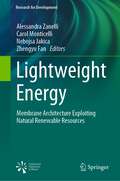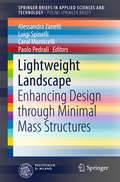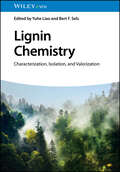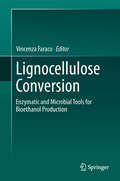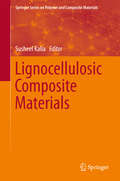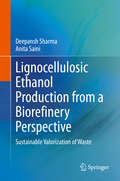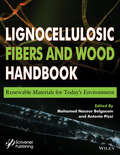- Table View
- List View
Lightwave Engineering (Optical Science and Engineering)
by Yasuo KokubunSuitable as either a student text or professional reference, Lightwave Engineering addresses the behavior of electromagnetic waves and the propagation of light, which forms the basis of the wide-ranging field of optoelectronics. Divided into two parts, the book first gives a comprehensive introduction to lightwave engineering using plane wave and then offers an in-depth analysis of lightwave propagation in terms of electromagnetic theory. Using the language of mathematics to explain natural phenomena, the book includes numerous illustrative figures that help readers develop an intuitive understanding of light propagation. It also provides helpful equations and outlines their exact derivation and physical meaning, enabling users to acquire an analytical understanding as well. After explaining a concept, the author includes several problems that are tailored to illustrate the explanation and help explain the next concept. The book addresses key topics including fundamentals of interferometers and resonators, guided wave, optical fibers, and lightwave devices and circuits. It also features useful appendices that contain formulas for Fourier transform, derivation of Green's theorem, vector algebra, Gaussian function, cylindrical function, and more. Ranging from basic to more difficult, the book’s content is designed for easily adjustable application, making it equally useful for university lectures or a review of basic theory for professional engineers.
Lightweight and Sustainable Materials for Automotive Applications
by Omar Faruk Jimi Tjong Mohini SainAutomotive manufacturers are required to decrease CO2 emissions and increase fuel economy while assuring driver comfort and safety. In recent years, there has been rapid development in the application of lightweight and sustainable materials in the automotive industry to help meet these criteria. This book provides critical reviews and the latest research results of various lightweight and sustainable materials in automotive applications. It discusses current applications and future trends of lightweight materials in the automotive area. While there are a few books published mainly focusing on automotive applications of metallic lightweight materials, to date there is no available book focusing on a broad spectrum of lightweight materials, including metal, plastic, composites, bio-fiber, bio-polymer, carbon fiber, glass fiber, nanomaterials, rubber materials, and foaming materials, as this work does. The book also includes case studies of commercial lightweight automotive parts from sustainable lightweight materials, providing an invaluable resource to those involved in this in-demand research and commercialization area.
Lightweight and Sustainable Materials for Automotive Applications
by Omar Faruk Jimi Tjong Mohini SainAutomotive manufacturers are required to decrease CO2 emissions and increase fuel economy while assuring driver comfort and safety. In recent years, there has been rapid development in the application of lightweight and sustainable materials in the automotive industry to help meet these criteria. This book provides critical reviews and the latest research results of various lightweight and sustainable materials in automotive applications. It discusses current applications and future trends of lightweight materials in the automotive area. While there are a few books published mainly focusing on automotive applications of metallic lightweight materials, to date there is no available book focusing on a broad spectrum of lightweight materials, including metal, plastic, composites, bio-fiber, bio-polymer, carbon fiber, glass fiber, nanomaterials, rubber materials, and foaming materials, as this work does. The book also includes case studies of commercial lightweight automotive parts from sustainable lightweight materials, providing an invaluable resource to those involved in this in-demand research and commercialization area.
Lightweight Energy: Membrane Architecture Exploiting Natural Renewable Resources (Research for Development)
by Alessandra Zanelli Carol Monticelli Nebojsa Jakica Zhengyu FanThis book explores membrane materials as a means of translating natural and renewable resources into a more flexible, dynamic, and reactive architectural skin. It represents the first time that energy-saving design has been addressed systematically in relation to lightweight building systems and tensile membranes. Understanding of the energetic behavior of membranes and foils used as a building envelope is a fundamental theme, as it is the integration of flexible photovoltaics in membranes, as well as the exploitation of water and wind resources. A theoretical, methodological framework for consciously designing the membrane life cycle is presented. The authors cross-cut and combine exploration of climate-based design methodology and life cycle thinking strategies. Both active and passive systems are investigated, referring to alternative productive resources like sun, wind, and water. Case studies are brought forward in the book’s second half, highlighting energy lightness for an increasingly dematerialized architecture and addressing inherent issues. Four main research and development paths are presented, the first two focusing on advancements in façade materials and Photovoltaic systems applicable to membrane architecture, the third referring to fog and dew harvesting and the fourth dealing with the future frontier of flexible transparency and designs for well-being through a passive solar system.
Lightweight Landscape: Enhancing Design through Minimal Mass Structures (SpringerBriefs in Applied Sciences and Technology)
by Alessandra Zanelli Luigi Spinelli Carol Monticelli Paolo PedraliThis book explains how lightweight materials and structures can be deployed in buildings to meet high environmental and aesthetic standards and emphasizes how the concept of lightness in building technology and design dovetails with the desire to enhance landscape. The first part of the book, on lightweight construction, aims to foster the use of membranes within the specific climatic context and in particular considers how lightweight materials and innovative technologies can enrich the quality of temporary spaces. The second part focuses exclusively on landscape, presenting novel approaches in the search for visual lightness and the quest to improve urban spaces. Particular attention is paid to the Italian experience, where the traditional appreciation of brick and stone has limited the scope for use of lightweight structures and membrane materials, often relegating them to a secondary or inappropriate role. The reader will come to appreciate how this attitude demeans a very advanced productive sector and neglects the ancient tradition of temporary architecture.
Lightweight Sandwich Construction
by J. M. DaviesSandwich panels are being used increasingly as the cladding of buildings like factories, warehouses, cold stores and retail sheds. This is because they are light in weight, thermally efficient, aesthetically attractive and can be easily handled and erected. However, to date, an authoritative book on the subject was lacking. This new reference work aims to fill that gap. The designer, specifier and manufacturer of sandwich panels all require a great deal of information on a wide range of subjects. This book was written by a group of European experts under the editorship of a UK specialist in lightweight construction. It provides guidance on: * materials used in manufacture * thermal efficiency and air- and water-tightness * acoustic performance * performance in fire * durability * special problems of sandwich panels in cold stores and chill rooms * architectural and aesthetic considerations * structural design at the ultimate and serviceability limit states * additional structural considerations including fastenings, the effect of openings and the use of sandwich panels as load-bearing walls * test procedures The book concludes with some numerical design examples and is highly illustrated throughout.
The Lignan Handbook
by Norman G. Lewis Laurence B. Davin V. Ranjit N. Munasinghe Andrew D. RobertsLignans are aromatic compounds isolated from plants. This handbook presents an authoritative and comprehensive review of lignan chemistry, biochemistry, nomenclature, uses, and occurrence. Lignans are used in a wide variety of industries and this book will appeal to those working in the pulp and paper industries, renewable energy, specialty chemicals, pharmaceuticals, flavors and fragrances, agriculture and forestry, evolution and ecology. Additionally, the book features a comprehensive lignans dictionary section, drawn from the prestigious Dictionary of Natural Products. Other features include: Presents a comprehensive and up-to-date account of this important group of natural products Addresses and resolves problems in current lignan nomenclature Edited by the leaders in the field of lignan chemistry and biochemistry
The Lignan Handbook
by Norman G. Lewis Laurence B. Davin V. Ranjit N. Munasinghe Andrew D. RobertsLignans are aromatic compounds isolated from plants. This handbook presents an authoritative and comprehensive review of lignan chemistry, biochemistry, nomenclature, uses, and occurrence. Lignans are used in a wide variety of industries and this book will appeal to those working in the pulp and paper industries, renewable energy, specialty chemicals, pharmaceuticals, flavors and fragrances, agriculture and forestry, evolution and ecology. Additionally, the book features a comprehensive lignans dictionary section, drawn from the prestigious Dictionary of Natural Products. Other features include: Presents a comprehensive and up-to-date account of this important group of natural products Addresses and resolves problems in current lignan nomenclature Edited by the leaders in the field of lignan chemistry and biochemistry
Lignin: Biosynthesis and Transformation for Industrial Applications (Springer Series on Polymer and Composite Materials)
by Swati Sharma Ashok KumarThis book presents a comprehensive overview on origin, structure, properties, modification strategies and applications of the biopolymer lignin. It is organized into four themed parts. The first part focuses on the analysis and characterization of the second most abundant biopolymer. The following part is devoted to the biological aspects of lignin such as biosynthesis and degradation. In the third part, chemical modification strategies and the preparation of composites as well as nano- and microparticles are discussed.The final part addresses the industrial application of lignin and its derivatives, as well as lignin materials. The usage for synthesis of biofuels, fine chemicals and in agriculture and food industry is covered.This book is a comprehensive source for researchers, scientists and engineers working in the field of biopolymers as well as renewable materials and sources.
Lignin Chemistry: Characterization, Isolation, and Valorization
by Bert F. Sels Yuhe LiaoLignin Chemistry A thorough reference guide to Lignin Chemistry, from inherent structure revealing to transformation into chemicals, fuels, and materials Climate change, driven by rising greenhouse gas emissions, is the defining challenge of our time. Reducing our dependence on non-renewable resources such as fossil fuels will require alternative, more sustainable resources. Lignin, the only widely-occurring, renewable, aromatic bio-polymer in Nature, has a range of application potential in the production of chemicals, fuels, and other industrial materials. Lignin science has become one of the fastest-growing and most significant areas of sustainable chemistry in the world. Lignin Chemistry: Characterization, Isolation, and Valorization presents a systematic, multidisciplinary overview of this cutting-edge field and its current state of research. Beginning with a robust characterization of lignin, the book addresses the isolation and transformation of lignin, as well as the book inspires with a plethora of applications. The result is a critical resource for researchers and professionals in any area of academic or industry where renewable biomass, in particular lignin, has importance. Lignin Chemistry readers will find: Thermochemical and catalytic strategies for lignin conversionDetailed discussion of the valorization of lignin towards biopolymers, nanoparticles, carbon fibers and materials, and hydrogelsAn authorial team with immense and varied research experience Lignin Chemistry is ideal for chemical engineers, catalytic chemists, biochemists, material scientists, and analytical chemists in industry.
Lignin Chemistry: Characterization, Isolation, and Valorization
by Bert F. Sels Yuhe LiaoLignin Chemistry A thorough reference guide to Lignin Chemistry, from inherent structure revealing to transformation into chemicals, fuels, and materials Climate change, driven by rising greenhouse gas emissions, is the defining challenge of our time. Reducing our dependence on non-renewable resources such as fossil fuels will require alternative, more sustainable resources. Lignin, the only widely-occurring, renewable, aromatic bio-polymer in Nature, has a range of application potential in the production of chemicals, fuels, and other industrial materials. Lignin science has become one of the fastest-growing and most significant areas of sustainable chemistry in the world. Lignin Chemistry: Characterization, Isolation, and Valorization presents a systematic, multidisciplinary overview of this cutting-edge field and its current state of research. Beginning with a robust characterization of lignin, the book addresses the isolation and transformation of lignin, as well as the book inspires with a plethora of applications. The result is a critical resource for researchers and professionals in any area of academic or industry where renewable biomass, in particular lignin, has importance. Lignin Chemistry readers will find: Thermochemical and catalytic strategies for lignin conversionDetailed discussion of the valorization of lignin towards biopolymers, nanoparticles, carbon fibers and materials, and hydrogelsAn authorial team with immense and varied research experience Lignin Chemistry is ideal for chemical engineers, catalytic chemists, biochemists, material scientists, and analytical chemists in industry.
Lignin Chemistry (Topics in Current Chemistry Collections)
The series Topics in Current Chemistry Collections presents critical reviews from the journal Topics in Current Chemistry organized in topical volumes. The scope of coverage is all areas of chemical science including the interfaces with related disciplines such as biology, medicine and materials science. The goal of each thematic volume is to give the non-specialist reader, whether in academia or industry, a comprehensive insight into an area where new research is emerging which is of interest to a larger scientific audience.Each review within the volume critically surveys one aspect of that topic and places it within the context of the volume as a whole. The most significant developments of the last 5 to 10 years are presented using selected examples to illustrate the principles discussed. The coverage is not intended to be an exhaustive summary of the field or include large quantities of data, but should rather be conceptual, concentrating on the methodological thinking that will allow the non-specialist reader to understand the information presented. Contributions also offer an outlook on potential future developments in the field.The chapter "Lignin‑Based Composite Materials for Photocatalysis and Photovoltaics" is available open access under a CC BY 4.0 License via link.springer.com.
Lignocellulose-Based Bioproducts (Biofuel and Biorefinery Technologies #1)
by Keikhosro KarimiThis volume provides the technical information required for the production of biofuels and chemicals from lignocellulosic biomass. It starts with a brief overview of the importance, applications, and production processes of different lignocellulosic products. Further chapters review the perspectives of waste-based biofuels and biochemicals; the pretreatment of lignocellulosic biomass for biofuel production; cellulolytic enzyme systems for the hydrolysis of lignocelluloses; and basic and applied aspects of the production of bioethanol, biogas, biohydrogen, and biobutanol from lignocelluloses.This book is recommended for researchers and engineers and particularly students taking biofuel courses at graduate level.
Lignocellulose Conversion: Enzymatic and Microbial Tools for Bioethanol Production
by Vincenza FaracoBioethanol has been recognized as a potential alternative to petroleum-derived transportation fuels. Even if cellulosic biomass is less expensive than corn and sugarcane, the higher costs for its conversion make the near-term price of cellulosic ethanol higher than that of corn ethanol and even more than that of sugarcane ethanol. Conventional process for bioethanol production from lignocellulose includes a chemical/physical pre-treatment of lignocellulose for lignin removal, mostly based on auto hydrolysis and acid hydrolysis, followed by saccharification of the free accessible cellulose portions of the biomass. The highest yields of fermentable sugars from cellulose portion are achieved by means of enzymatic hydrolysis, currently carried out using a mix of cellulases from the fungus Trichoderma reesei. Reduction of (hemi)cellulases production costs is strongly required to increase competitiveness of second generation bioethanol production. The final step is the fermentation of sugars obtained from saccharification, typically performed by the yeast Saccharomyces cerevisiae. The current process is optimized for 6-carbon sugars fermentation, since most of yeasts cannot ferment 5-carbon sugars. Thus, research is aimed at exploring new engineered yeasts abilities to co-ferment 5- and 6-carbon sugars. Among the main routes to advance cellulosic ethanol, consolidate bio-processing, namely direct conversion of biomass into ethanol by a genetically modified microbes, holds tremendous potential to reduce ethanol production costs. Finally, the use of all the components of lignocellulose to produce a large spectra of biobased products is another challenge for further improving competitiveness of second generation bioethanol production, developing a biorefinery.
Lignocellulosic Biomass Refining for Second Generation Biofuel Production (Novel Biotechnological Applications for Waste to Value Conversion)
by Ponnusami V.This book compiles research aspects of second generation (2G) biofuel production specifically sourced from lignocellulose biomass with the direction of biorefinery means. It focusses on the valorization of different sources of 2G biofuels and their relative importance. The constituents of lignocelluloses and their potential characteristics, end utilization of biofuel from production are discussed. Different means of treatments of lignocellulose through physical, physio-chemical, microbial, and enzymatic approaches are also included. Features: Describes technological advancements for bioethanol production from lignocellulosic waste. Provides the roadmap for the production and utilization of 2G Biofuels. Introduces the strategic role of metabolic engineering in the development of 2G biofuels. Discusses technological advancements, life cycle assessment, and prospects. Explores the novel potential lignocellulosic biomass for 2G biofuels. This book is aimed at researchers and professionals in renewable energy, biofuel, bioethanol, lignocellulose conversion, fermentation, and chemical engineering.
Lignocellulosic Biomass Refining for Second Generation Biofuel Production (Novel Biotechnological Applications for Waste to Value Conversion)
This book compiles research aspects of second generation (2G) biofuel production specifically sourced from lignocellulose biomass with the direction of biorefinery means. It focusses on the valorization of different sources of 2G biofuels and their relative importance. The constituents of lignocelluloses and their potential characteristics, end utilization of biofuel from production are discussed. Different means of treatments of lignocellulose through physical, physio-chemical, microbial, and enzymatic approaches are also included. Features: Describes technological advancements for bioethanol production from lignocellulosic waste. Provides the roadmap for the production and utilization of 2G Biofuels. Introduces the strategic role of metabolic engineering in the development of 2G biofuels. Discusses technological advancements, life cycle assessment, and prospects. Explores the novel potential lignocellulosic biomass for 2G biofuels. This book is aimed at researchers and professionals in renewable energy, biofuel, bioethanol, lignocellulose conversion, fermentation, and chemical engineering.
Lignocellulosic Composite Materials (Springer Series on Polymer and Composite Materials)
by Susheel KaliaThis book comprehensively summarizes important aspects of research in the active field of lignocellulosic (polymer) composites, including polymer materials from or containing cellulose, hemicellulose and lignin. It describes how these materials can be produced from forest products and natural fibers from sources such as jute, flax, sisal, and many more, and even from agricultural residues (like wheat straw, corn stover, or sugarcane bagasse). In times of high demand for renewable green materials, lignocellulosic materials from organic matter produced by trees, shrubs and agricultural crops present a highly attractive feedstock.The international authors explain different treatment and fabrication methods for the production of lignocellulosic materials. Other chapters address the properties of these green materials or illustrate specific applications, ranging from food packaging and household products to adsorbents and even conductive polymer composites. In this way, this book offers a broad and comprehensive overview over the entire field of lignocellulosic composite materials.
Lignocellulosic Ethanol Production from a Biorefinery Perspective: Sustainable Valorization of Waste
by Deepansh Sharma Anita SainiThis book provides an overview of the multi-dimensional approach for the production of ethanol from lignocellulosic biomass. The sustainability of this biofuel, the current and future status of the technology and its role in waste valorization are also addressed.Bioethanol from lignocellulosic material has emerged as an alternative to the traditional first-generation bioethanol. The book also discusses various pretreatment methods for effective separation of the various components of lignocellulosic feedstock as well as their advantages, and limitations. It describes the valorization of lignocellulosic waste through the production of bioethanol and emphasizes the significance of waste utilization in managing the production cost of the fuel. Finally, the utilization of genetically engineered plants and microorganisms to increase the conversion efficiency is reviewed.
Lignocellulosic Fibers: Sustainable Biomaterials for Green Composites (SpringerBriefs in Materials)
by Khubab Shaker Yasir NawabThe book is primarily focused on natural plant (lignocellulosic) fibers as sustainable reinforcement material for green composites. It begins with a brief introduction to common plant-based reinforcements, their extraction techniques, the structure of plant fibers, and describes novel fibers extracted from fruit, seeds, leaf, bast, and agricultural waste. The book then focuses on the application of these fibers as reinforcements for composite materials, covering reinforcement and composite fabrication techniques, as well as their performance evaluation. Overall, the book provides a unique and comprehensive look at lignocellulosic fibers for use in green composites, appealing to both researchers in the area of sustainable materials and industry professionals and entrepreneurs interested in their utilization in value-added composite products.
Lignocellulosic Fibers and Wood Handbook: Renewable Materials for Today's Environment
by Naceur Belgacem Antonio PizziThis book will focus on lignocellulosic fibres as a raw material for several applications. It will start with wood chemistry and morphology. Then, some fibre isolation processes will be given, before moving to composites, panel and paper manufacturing, characterization and aging.
Lignocellulosic Fibers and Wood Handbook: Renewable Materials for Today's Environment
by Antonio Pizzi Mohamed Naceur BelgacemThis book will focus on lignocellulosic fibres as a raw material for several applications. It will start with wood chemistry and morphology. Then, some fibre isolation processes will be given, before moving to composites, panel and paper manufacturing, characterization and aging.
Lignocellulosic Materials and Their Use in Bio-based Packaging (SpringerBriefs in Molecular Science)
by Lina Fernanda Ballesteros Michele Michelin António Augusto Vicente José António Teixeira Miguel Ângelo CerqueiraThis brief provides a comprehensive review of lignocellulosic materials and their primary role in the future development of bio-based packaging. Topics such as: sources and extraction methods of lignocellulosic materials; main constituents of lignocellulosic materials; functionality of lignocellulosic materials; the development of bio-based and biodegradable packaging; incorporation of lignocellulosic materials in bio-based packaging materials; properties and functionality of bio-based packaging, are discussed by authors who are experts in the field.
Lignocellulosic Polymer Composites: Processing, Characterization, and Properties (Polymer Science and Plastics Engineering)
by Vijay Kumar ThakurThe book presents emerging economic and environmentally friendly lignocellulosic polymer composites materials that are free from side effects studied in the traditional synthetic materials. This book brings together panels of highly-accomplished leading experts in the field of lignocellulosic polymers & composites from academia, government, as well as research institutions across the globe and encompasses basic studies including preparation, characterization, properties and theory of polymers along with applications addressing new emerging topics of novel issues. Provide basic information and clear understanding of the present state and the growing utility of lignocellulosic materials from different natural resources Includes contributions from world-renowned experts on lignocellulosic polymer composites and discusses the combination of different kinds of lignocellulosic materials from natural resources Discusses the fundamental properties and applications of lignocellulosic polymers in comparison to traditional synthetic materials Explores various processing/ mechanical/ physic-chemical aspects of lignocellulosic polymer composites
Lignocellulosic Polymer Composites: Processing, Characterization, and Properties (Polymer Science and Plastics Engineering)
by Vijay Kumar ThakurThe book presents emerging economic and environmentally friendly lignocellulosic polymer composites materials that are free from side effects studied in the traditional synthetic materials. This book brings together panels of highly-accomplished leading experts in the field of lignocellulosic polymers & composites from academia, government, as well as research institutions across the globe and encompasses basic studies including preparation, characterization, properties and theory of polymers along with applications addressing new emerging topics of novel issues. Provide basic information and clear understanding of the present state and the growing utility of lignocellulosic materials from different natural resources Includes contributions from world-renowned experts on lignocellulosic polymer composites and discusses the combination of different kinds of lignocellulosic materials from natural resources Discusses the fundamental properties and applications of lignocellulosic polymers in comparison to traditional synthetic materials Explores various processing/ mechanical/ physic-chemical aspects of lignocellulosic polymer composites
Like A House On Fire: ‘Painfully astute and brilliantly funny . . . I loved it’ Beth O'Leary, author of The Flatshare
by Caroline Hulse'Acutely observed and brilliantly funny' CLARE MACKINTOSH'A triumph of a novel' BETH O'LEARY* * * * * * * Things Stella and George have had blazing rows about:- Misquoting Jurassic Park.- Leaving a Coke can on the side of the bath.- Fitting car seats for their hypothetical kids.In other news, they're getting divorced.But first, Stella's mum is throwing a murder mystery party and - with her dad losing his job, her mum's recent diagnosis, and some very odd behaviour from her sister - now is not the time to tell everyone.All Stella and George have to do is make it through the day without their break-up being discovered - though it will soon turn out that having secrets runs in the family...More praise for LIKE A HOUSE ON FIRE: 'Funny and sad and relateable and deeply human' HARRIET TYCE'Part Fleabag, part Agatha Christie, Like A House On Fire is everything I love in a book...I was hooked from page one. Bravo, what a triumph!' JOSIE SILVER'Sheer delight from start to finish' LESLEY KARA'Painfully astute and brilliantly funny' BETH O'LEARY'Witty, whip-smart and wincingly observant, pure entertainment from start to finish. A Caroline Hulse book is a reading highlight of my year' CATHY BRAMLEY'Absolutely loved Like A House On Fire. A proper delight' RICHARD ROPER'Hilarious and brilliant and clever in that way only Caroline knows how to be. So compelling, I couldn't put it down' LUCY VINE'Caroline Hulse is a very funny writer and a wonderfully compassionate observer of human frailty' KATE EBERLEN'Funny, moving and astute. A triumph!' NICOLA MOSTYN


